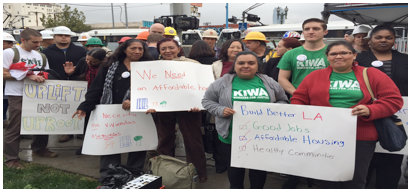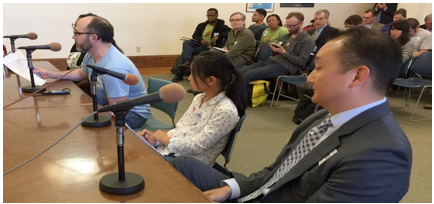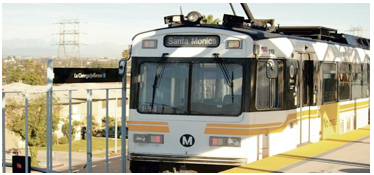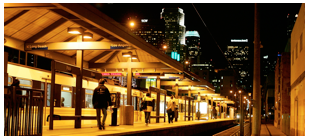Saving San Pedro (or the Nation) from Itself
AT LENGTH-It’s happening across the country -- a populist backlash from the right and the left -- the flames of which are nipping at the heels of marginalized communities, whether they’re immigrants, Muslim, transgender or homeless or a part of the billionaire class or the corrupt Wall Street bankers and brokers. Both sides of this populist uprising can be heard via social media and other media outlets during this presidential election cycle.
The cacophony of narratives and counter narratives of conservative and progressive authenticity has become only slightly less chaotic with the elimination of 16 GOP rivals from our rather curious primary election system.
It has often been said that all politics is local and it can’t get any more local than at any of the 96 neighborhood councils in Los Angeles that are also having their elections this month and next.
There are 33 and 35 candidates respectively running for Central’s and Coastal’s Neighborhood Council’s 17 seats -- vying for the privilege to donate hours of unpaid service to democratically represent stakeholders in a body that has no more than an “advisory” role in city politics.
In the interest of transparency, I am one of those candidates running for re-election to the Central San Pedro Neighborhood Council. I have also been a target for some people who claim they are “Saving San Pedro.” This phrase sounds a similar note as Donald Trump’s “Make America Great Again,” suggesting that San Pedro is in decline if not in some state of arrested development. In a political climate such as this, theirs is a great political slogan.
Slogans, however, are not platforms. Nor are they an agenda that can accomplish anything. They are, at their root, a form of political propaganda intended to encapsulate an idea to motivate voters or to deceive them.
Yet, so much of what is behind both Trump and the creators of Saving San Pedro -- a Facebook group that rose up against the San Pedro homeless advocates and then belatedly filed for non-profit status -- is a fear of all the things they don’t understand, be it immigrants or the homeless.
Both the Trumpites and our local Savers are nativist, NIMBY reactions to serious economic conditions that are more complex and harder to solve than building a wall on a border or deploying the police to evict homeless encampments from public spaces. Anyone who knows anything on either subject will tell you that you can’t arrest your way out of illegal immigration or homelessness. Yet, that’s mostly what’s being done about the homeless in Los Angeles City Council District 15, with the exception of the work done by Harbor Interfaith Services’ workers and two LAPD quality of life officers.
Since last August, when our Central San Pedro Neighborhood Council brought the plight of our unsheltered neighbors to the attention of the community and all of Los Angeles, Councilman Joe Buscaino quickly held a community forum on the subject and appointed a taskforce.
Unfortunately, that task force held private meetings and didn’t include anyone from our neighborhood council and has yet to issue a report of its findings or even an action plan on dealing with our rather small, yet growing homeless population.
Despite Buscaino’s enforcement approach and the Los Angeles City Council promising but not producing $100 million to address homelessness, the Los Angeles Homeless Services Authority announced May 9 that the number of homeless in Council District 15 rose from 1,544 in 2015 to 1,773 this year.
Several of the San Pedro Savers are on Buscaino’s taskforce and as I’ve said before, they have yet to come up with a solution other than continued forced evictions and prohibiting the feeding of the homeless in public parks.
Are you serious, you might ask? Sure, a small number of homeless people have been given assistance yet it is obvious by the increase that this clearly isn’t enough.
The Savers have been very bold in shaming the homeless on their favorite medium, Facebook -- shouting down anyone who challenges them there and confiscating unprotected shopping carts while claiming that “all the homeless are criminals or drug addicts.”
The statistics from the recent homeless count prove these allegations untrue, as mental illness tops the list and substance abuse comes in third just above domestic violence. Several of the Saving San Pedro folks, along with Buscaino, are in the process of being sued for harassment and one of them, Joanne Rallo, is due back in court May 20 on a restraining order.
While the challenge of homelessness has become a greater problem all across America, with Los Angeles County being the epicenter, it is not a singular problem solved with a simple solution -- especially with the decline in affordable housing, the loss of good middle class jobs, the pressure to gentrify neighborhoods and a flat-line growth in real wages for over three decades.
Yes, I hear that people are angry and I actually understand that anger. But I don’t go around blaming the victims just to make myself or my neighbors feel better.
I have said this before and I’ll say it again: Conflict precedes resolution. Only after everybody is done yelling can there be any commitment to resolving a problem. I believe that for every human problem there is a humane solution.
As for now, the lines have been drawn between progressives and nativist populists, and the one solution we have come to embrace since the American Civil War is the ballot box. As you might well suspect, I endorse both the progressive slate at the Coastal and Central neighborhood councils, as well as Bernie Sanders for president. This is the point at which you connect your local interests to the national politics and then recognize that democracy only matters if you show up and vote.
(James Preston Allen is the Publisher of Random Lengths News, the Los Angeles Harbor Area's only independent newspaper. He is also a guest columnist for the California Courts Monitor and is the author of "Silence Is Not Democracy - Don't listen to that man with the white cap - he might say something that you agree with!" He was elected to the presidency of the Central San Pedro Neighborhood Council in 2014 and has been engaged in the civic affairs of CD 15 for more than 35 years. More of Allen … and other views and news at: randomlengthsnews.com.) Prepped for CityWatch by Linda Abrams.
-cw
















 Despite law enforcement's extensive training and new resources, the problems of homelessness and mental illness are vast. Last year, Los Angeles County District Attorney Jackie Lacey presented a comprehensive plan to the Board of Supervisors that recommends enhanced treatment and services to safely divert mentally ill offenders from the county jail. In Los Angeles, the Sheriff's Department and the LAPD are constantly collaborating with the various public and private sector organizations to better address the behavior of mentally ill individuals. However, at the end of the day, it is the community of Los Angeles that must demand of our elected leaders at both the state and local level a comprehensive plan to combat the true roots of homelessness.
Despite law enforcement's extensive training and new resources, the problems of homelessness and mental illness are vast. Last year, Los Angeles County District Attorney Jackie Lacey presented a comprehensive plan to the Board of Supervisors that recommends enhanced treatment and services to safely divert mentally ill offenders from the county jail. In Los Angeles, the Sheriff's Department and the LAPD are constantly collaborating with the various public and private sector organizations to better address the behavior of mentally ill individuals. However, at the end of the day, it is the community of Los Angeles that must demand of our elected leaders at both the state and local level a comprehensive plan to combat the true roots of homelessness. 
 No, they clearly won't--and what they'll do is drive to the Venice/Robertson or La Cienega stations, where there is parking that's now occupied by 8-9 am, and where Downtown-bound traffic bunches up on the I-10.
No, they clearly won't--and what they'll do is drive to the Venice/Robertson or La Cienega stations, where there is parking that's now occupied by 8-9 am, and where Downtown-bound traffic bunches up on the I-10. 



















